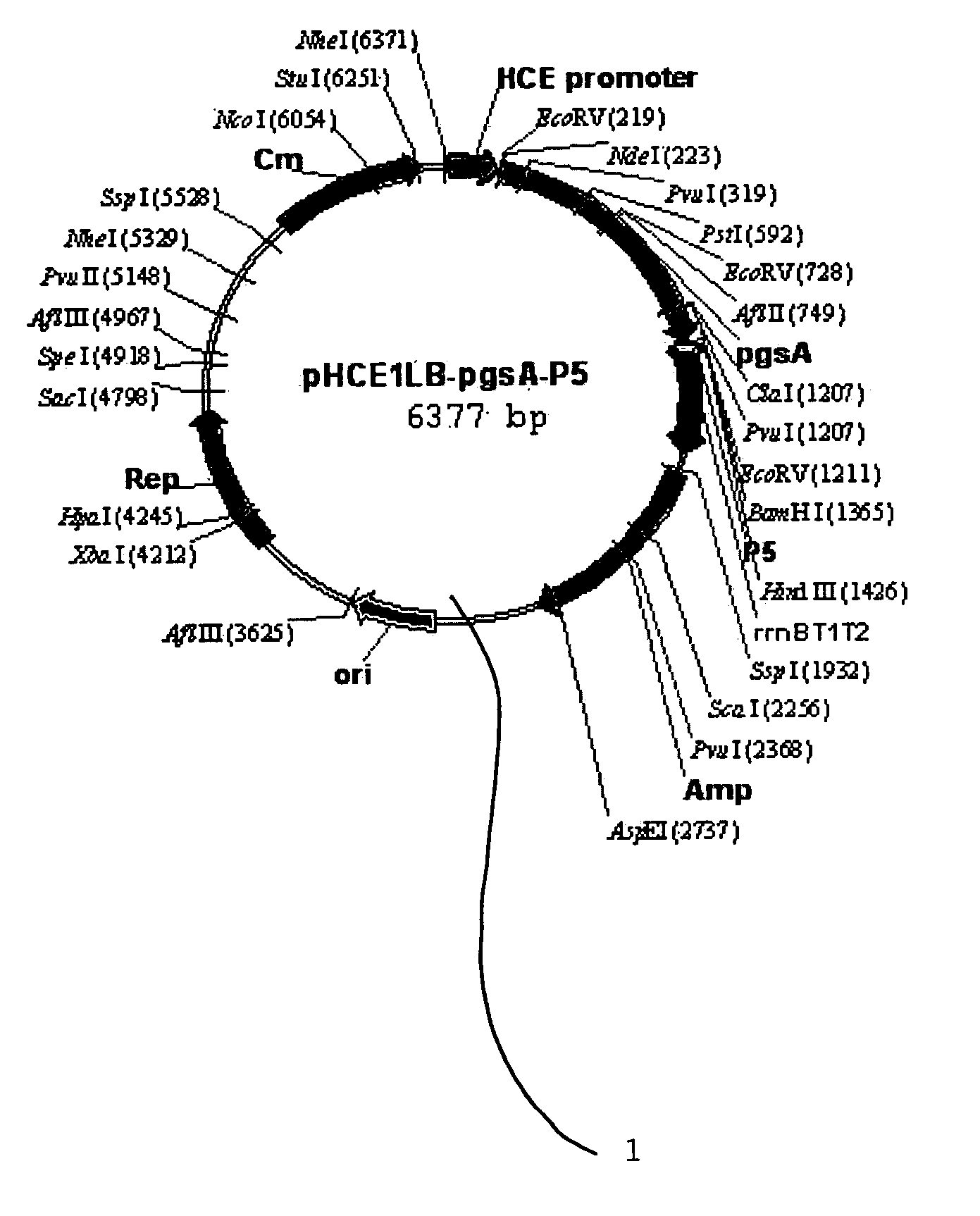Surface expression method of peptides P5 and ANAL3 using the gene encoding poly-gamma-glutamate synthetase
a surface expression and polygamma-glutamate technology, applied in the field of surface expression of peptides p5 and anal3, can solve the problems of low economic efficiency of peptide antibiotic production by chemical synthesis, cannot be provided at low prices and large amounts, and cannot be applied to the above-mentioned peptide antibiotics, etc., to achieve simple, easy and safe manner, effective expression, and simple
- Summary
- Abstract
- Description
- Claims
- Application Information
AI Technical Summary
Benefits of technology
Problems solved by technology
Method used
Image
Examples
example 1
Production of Transformation Vector pHCE1LB:A-P5 For Surface Expression, and Surface Expression of Peptide P5 Fused with pgsA
[0049] (1) Production of Transformation Vector pHCE1LB:pgsA-P5 1 for Surface Expression Against Peptide Antibiotics P5
[0050]FIG. 1 is a genetic map of the transformation vector pHCE1LB:pgsA-P5 1 for surface expression, which uses gram-negative and gram-positive microorganisms as hosts. The pgsA gene among the genes pgsBCA, which are derived from Bacillus subtilis var. chungkookjang (KCTC 0697BP) and involved in the synthesis of poly-gamma-glutamate, was inserted into the basic vector pHCE1LB using gram-negative and gram-positive microorganisms as hosts, thereby constructing intermediate vector pHCE1LB. In order to introduce peptide antibiotics P5-encoding gene into the intermediate vector, the intermediate vector was added with an oligonucleotide having the base sequences of SEQ ID NO: 4 and SEQ ID NO: 5, and denatured for 5 minutes at 95° C., followed by an...
example 2
Measurement of Antifungal Activity of Lactobacillus Expressing Peptide Antibiotics P5 on Their Surface
[0056] (1) In order to measure the antifungal activity of Lactobacillus which had been found in Example 1 to surface-express the peptide antibiotics P5, a visualization test of antifungal activity was conducted on pathogenic fungi Candida albicans (TIMM 1768) and Trichosporon beigelii (KCTC 7707).
[0057] Concretely, 50 μl of a PDB medium (20% potato infusion from, 2% Bacto-dextrose) containing 2×103 fungi was placed into each well of a 96-well plate, and 50 μl / well of MRS medium containing the Lactobacillus expressing the peptide P5 was successively diluted 1 / 2 times, and added to the fungi-containing well, followed by culturing at 37° C. for 16 hours. The cultured solution was plated on a PDB agar plate to visualize the strains. As a result, a large number of colonies could be found on the plates on which Trichosporon beigelii 11 and Candida albicans 21 themselves, and a mixture o...
example 3
Production of Transformation Vector pHCE1LB:A-Anal3 for Surface Expression, and Surface Expression of Peptide Anal3 Fused with psA
[0061] (1) Transformation vector pHCE1LB:A-Anal3 31, which can surface-express the peptide antibiotics Anal3, was produced in the same manner as in the part (1) of Example 1.
[0062] In order to introduce a peptide antibiotics Anal3-encoding gene into the intermediate vector pHCE1LB:pgsA, a genes having the base sequences of SEQ ID NO: 6 and SEQ ID NO: 7 and encoding the peptide Anal3 was annealed in the same manner as in Example 1, to give a 62-bp double helical sequence.
SEQ ID NO 65′-ga tcc gcg aag aag gtg ttc aaa cgc ctg gag aagctg ttt agc aaa atc tgg aac tgg aag ta-3′:SEQ ID NO: 75′-aag cta ctt cca gtt cca gat ttt gct aaa cagctt ctc cag gcg ttt gaa cac ctt ctt cgc g-3′:
[0063] Both ends of the double helical sequence formed by the base sequences of SEQ ID NO: 6 and SEQ ID NO: 7 were so constructed that they have recognition sites for restriction enzy...
PUM
| Property | Measurement | Unit |
|---|---|---|
| Acidity | aaaaa | aaaaa |
| Amphiphilicity | aaaaa | aaaaa |
| Antimicrobial properties | aaaaa | aaaaa |
Abstract
Description
Claims
Application Information
 Login to View More
Login to View More - R&D
- Intellectual Property
- Life Sciences
- Materials
- Tech Scout
- Unparalleled Data Quality
- Higher Quality Content
- 60% Fewer Hallucinations
Browse by: Latest US Patents, China's latest patents, Technical Efficacy Thesaurus, Application Domain, Technology Topic, Popular Technical Reports.
© 2025 PatSnap. All rights reserved.Legal|Privacy policy|Modern Slavery Act Transparency Statement|Sitemap|About US| Contact US: help@patsnap.com



